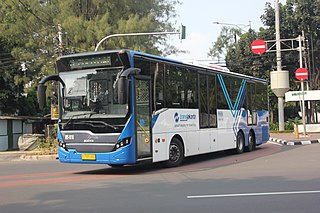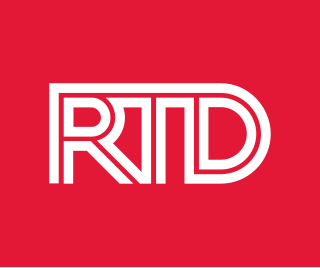
Bus rapid transit (BRT), also referred to as a busway or transitway, is a bus-based public transport system designed to have much more capacity, reliability and other quality features than a conventional bus system. Typically, a BRT system includes roadways that are dedicated to buses, and gives priority to buses at intersections where buses may interact with other traffic; alongside design features to reduce delays caused by passengers boarding or leaving buses, or paying fares. BRT aims to combine the capacity and speed of a light rail transit (LRT) or mass rapid transit (MRT) system with the flexibility, lower cost and simplicity of a bus system.

Miami-Dade Transit (MDT) is the primary public transit authority of Miami, Florida and the greater Miami-Dade County area. It is the largest transit system in Florida and the 15th-largest transit system in the United States. As of 2023, the system has 80,168,700 rides per year, or about 277,400 per weekday in the fourth quarter of 2023. MDT operates the Metrobus with their paratransit STS systems run by LSF. MDT also operates two rail transit systems: Metrorail and Metromover.

Calgary Transit is the public transit agency which is owned and operated by the city of Calgary, Alberta, Canada. In 2019, an estimated 106.5 million passengers boarded approximately 1,155 Calgary Transit vehicles. It operates light metro (LRT), urban tramway, bus rapid transit (BRT), para-transit, and regular bus services. In 2023, the system had a ridership of 144,385,200, or about 463,000 per weekday as of the fourth quarter of 2023.

The Regional Transportation Commission of Southern Nevada (RTC) is a government agency and the transit authority and the transportation-planning agency for Southern Nevada. It was founded by the Nevada Legislature in 1965.

Lynx is a transit system serving the greater Orlando, Florida area. Operated by the Central Florida Regional Transportation Authority, it provides bus, curb-to-curb, and paratransit services in three counties: Orange, Seminole, and Osceola. Bus routes are referred to as Links.

RTC Transit is the name of the public bus system in the Las Vegas metropolitan area of Clark County, Nevada. It is a subsidiary of the Regional Transportation Commission of Southern Nevada. While it services most of Clark County with regularly scheduled routes, most of the service is in the immediate Las Vegas Valley; outlying places such as Mesquite and Laughlin provide transit services to their residents via the Southern Nevada Transit Coalition, which uses several vehicles acquired from RTC Transit. In 2023, the system had a ridership of 52,734,200, or about 161,000 per weekday as of the fourth quarter of 2023.

The Deuce is a transit bus service serving the Las Vegas metropolitan area. Operated by RTC Transit, it began service on October 27, 2005. Originally The Deuce meant four things: (1) buses on the route were double decked; (2) the one-way fare was $2; (3) the route served the two primary gaming areas, the Strip and Downtown; and (4) the first batch of vehicles bought primarily for the service were assigned fleet numbers starting with "2". Although the double decker buses also serve other local routes and the price is no longer $2, the name The Deuce on the Strip is used by RTC to emphasize that the route refers to just the tourist route. In 2022, The Deuce had an annual ridership of 4,251,482. The Deuce operates 24 hours a day.

ABQ RIDE is the local transit agency serving Albuquerque, New Mexico. ABQ RIDE operates a variety of city bus routes including two Albuquerque Rapid Transit (ART) bus rapid transit lines and a currently suspended ARTx express bus line It is the largest public transportation system in the state, serving 6,907,500 passengers in 2023, or about 21,100 per weekday as of the fourth quarter of 2023.

The Interurban Transit Partnership, branded as The Rapid, is the public transit operator serving Grand Rapids, Michigan and its suburbs. In 2023, the system had a ridership of 6,239,500, or about 23,800 per weekday.

The Regional Transportation District, more commonly referred to as RTD, is the regional agency operating public transit services in eight out of the twelve counties in the Denver-Aurora-Boulder Combined Statistical Area in the U.S. state of Colorado. It operates over a 2,342-square-mile (6,070 km2) area, serving 3.08 million people. RTD was organized in 1969 and is governed by a 15-member, publicly elected Board of Directors. Directors are elected to a four-year term and represent a specific district of about 180,000 constituents.

The Emerald Express (EmX) is a bus rapid transit (BRT) system in the Eugene-Springfield metropolitan area in Oregon, United States. It is provided by the Lane Transit District (LTD) which is the public transit authority in Lane County, Oregon.
Las Vegas Transit, also known as Las Vegas Transit System (LVTS), was a former operator of a small private bus system in Las Vegas, Nevada, United States.

MAX is a bus rapid transit (BRT) service operated by Utah Transit Authority (UTA) along the Wasatch Front in Utah, United States. It is described by UTA as "light rail on rubber tires." As of August 2023, there is one BRT line in service in Utah County, one line in service in Weber County, one discontinued line in Salt Lake County, and two new routes planned for Salt Lake County.

The Regional Transportation Commission of Washoe County (RTC) is the public body responsible for the transportation needs throughout Reno, Sparks and Washoe County, Nevada. The RTC, founded by the Nevada Legislature in 1979, is an amalgamation of the Regional Street and Highway Commission, the Regional Transit Commission and the Washoe County Area Transportation Study Policy Committee. They provide public transportation services, street and highway construction, and transportation planning. In 2023, the system had a ridership of 5,162,600, or about 16,600 per weekday as of the fourth quarter of 2023.
Transportation in the Las Vegas Valley including the Nevada cities of Las Vegas, North Las Vegas and Henderson is a multi-faceted system. The street system is mostly laid out in a north–south/east–west system of roads. While most residents rely on cars, there is a network of bus routes reaching some areas of the county. The Las Vegas Valley, being the one of the largest tourist destinations in the world, has a mass transportation system which favors the Las Vegas Strip.

Metro is a transit network in Minnesota serving the cities of Minneapolis and Saint Paul. It also provides service to some suburban areas. As of 2022, the system consists of two light rail lines and five bus rapid transit (BRT) lines all of which are operated by the local public transit company: Metro Transit. The five lines connect Downtown Minneapolis and St Paul with the Bloomington, Minneapolis-St Paul International Airport, Roseville, Richfield, Burnsville and Brooklyn Center.

Bus rapid transit creep is a phenomenon where bus systems that fail to meet the requirements for being considered "true bus rapid transit" are designated as bus rapid transit regardless. These systems are often marketed as a fully realized bus rapid transit system, but end up being described as more of an improvement to regular bus service by proponents of the "BRT creep" term. The Institute for Transportation and Development Policy published several guidelines in an attempt to define what constitutes the term "true BRT", known as the BRT Standard, in an attempt to avert this phenomenon.

Rapid Central Station is an intermodal transit station in downtown Grand Rapids, Michigan. It is operated by the Interurban Transit Partnership and serves as Grand Rapids' main city bus station as well as a station on the Silver Line bus rapid transit. It is located on Grandville Avenue between Cherry Street and Wealthy Street, and is the BRT's northern terminus. It is just yards north of the city's intercity rail station, the Vernon J. Ehlers Station, on Century Avenue.

Flatiron Flyer is an 18-mile (29 km) express bus system between Denver, Aurora, and Boulder, Colorado, traveling along U.S. Route 36. Different levels of service are available, including a non-stop from Boulder to Union Station in high-occupancy toll lanes, and all-stop, which serves six park-and-rides along U.S. Route 36 in normal highway lanes. The line branches out to different destinations in Denver, Aurora and Boulder. The Regional Transportation District operates the line, opened on January 3, 2016.


















